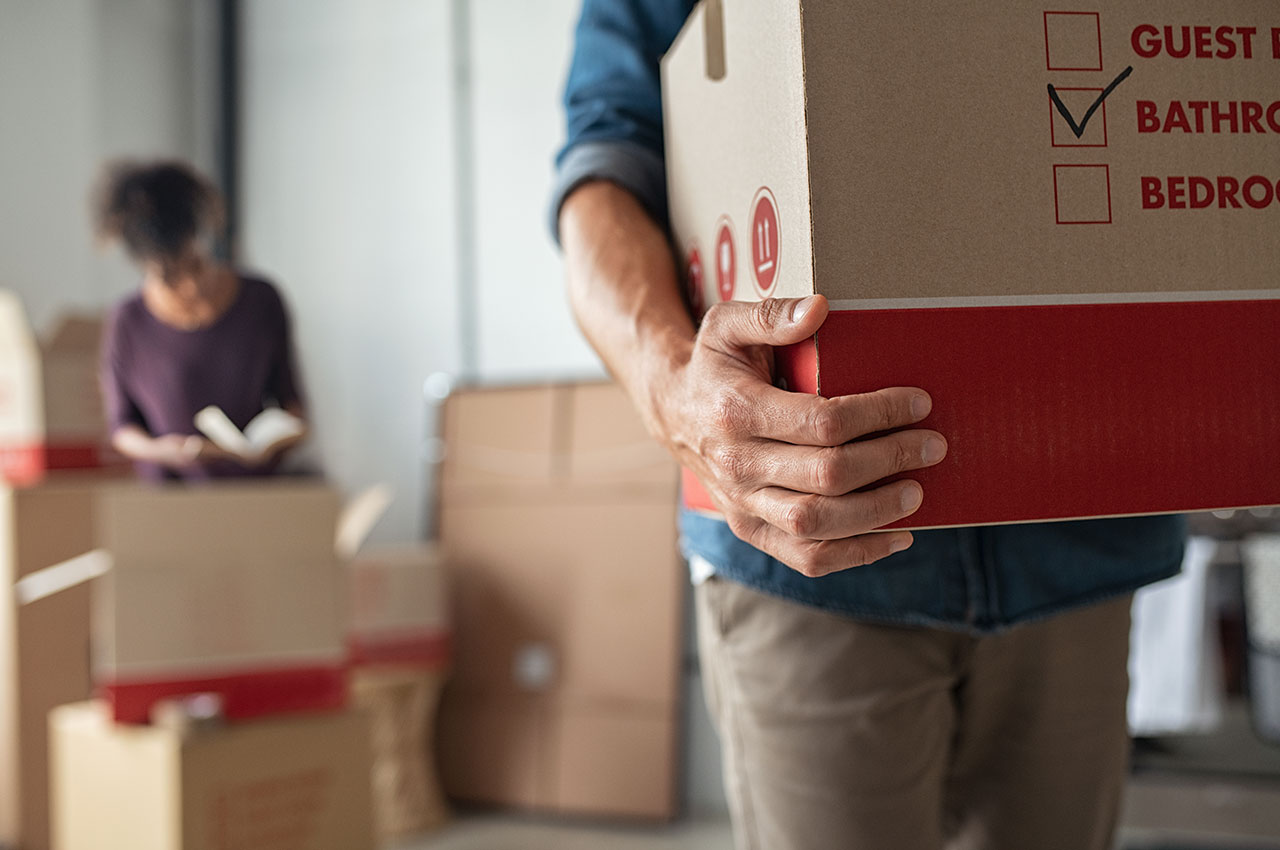Our Top Moving House Packing Tips

Moving home is widely regarded as one of the most stressful life events so we’ve put together some great moving house packing tips to make it a little easier.
Packing for a house move – What to do first
The success of your move is dependent on avoiding moving mistakes and planning ahead of time to make the process as smooth as possible. Including properly packing for your house move. Gather your packing materials:
- Boxes
- Packing tape
- Scissors
- Packing paper
- Bubble wrap
- Markers
- Old towels and blankets
- Plastic bags
- Colour-coded stickers
Set up your packing station
Set up a packing station in each room as you slowly pack each one. Setting up a packing station will save you time looking for supplies and will allow you to use the station to tape and label boxes.
Use your linens, towels and other soft items to pack fragile items
Wrap breakables like glasses or perfume bottles in socks for extra padding, and cushion fragile, difficult-to-wrap items like lamps and vases with linens and towels. In the kitchen, wrap knives and other sharp objects in dish towels and secure them with a rubber band. You’ll be surprised at how many items you already have around the house that can be used for packing.
Begin packing well in advance!
The entire moving process is usually very time consuming, depending on the number of items you have to move. This is why it is critical to begin the process sooner than most people believe. Packing a box, a day for two months should suffice for a larger house, while one month should suffice for a smaller house. This is only a rough estimate. After you’ve boxed up the majority of your belongings, you’ll have a better idea of what van size you’ll require, allowing you to book the van sooner.
Make a detailed inventory list
This is one our most important house packing tips. It not only helps you to remember everything but you’ll be able to find your items quickly and easily when you unpack.
Pack one room at a time
We recommend packing your belongings by room, as this is frequently overlooked. This will help you stay organised and will allow you to tell the movers, or anyone else unloading and unpacking, which box goes in which room. You can also start unloading and unpacking your belongings from the top to the bottom floor.
Pack rarely used items first
Start packing a box with the items you know will likely not need for a while.
After each packing session move your boxes
Moving boxes downstairs, to a garage or even just near the door will help to prevent muscle strain after the long days of moving.
Do not exceed the limit of 14kg (~30 lbs) per box
This is especially important if you are moving abroad, as there will undoubtedly be many more boxes to pack. It is also critical not to overpack a box, as this could result in a back injury or one of the boxes not being able to withstand the weight when moving it. As a result, it’s a good idea to pack light items in large boxes and heavy items in small boxes.
Roll your clothes
Rolling your clothes is the most practical method because it saves space, reduces the appearance of wrinkles in the clothing, saves time on ironing, and allows you to store more clothes in one box.
Use toilet roll tubes to pack cables and wiring
To minimise cable tangling, use toilet toll tubes to pack cables/appliances with long wires. It will enable you to pack multiple cables and appliances in a box without them becoming tangled.
Declutter and donate
It is critical to sort out what you want and don’t want to take to your new home when organising your belongings. You could hold a garage sale or donate unwanted items to charity with the items you don’t want. Decluttering your possessions will also help you save money on removal costs.

Label EVERYTHING
Writing the name of the room (you can also number each box and reference it on your inventory) on each box will help you remember which box belongs to which room and what it contains. Make sure to write on the sides of the boxes rather than the tops, as this will help you identify them if they are stacked. Using a different coloured marker for each room will also aid in determining which box belongs in which room.
Put heavier boxes on the bottom
Although this appears to be common sense, it is worth mentioning. By placing your heavy boxes beneath the lighter boxes, you ensure that no breakable items are crushed during the move. This can be done when loading furniture into solid containers or inside vehicles, for example.
Store all your valuable in one place
Use your detailed inventory list to ensure that you do not forget or lose anything. Pack all of your valuable belongings in one place like important documents (birth certificates, passports, bank account statements etc.) or high value items (jewellery, cash, credit cards) and carry them yourself if you can. If you’re carrying high value items, check you’re insured!
Dispose of hazardous materials
If you are moving internationally, most international removal companies will tell you that they do not transport such materials. Always inquire about the topic with the removal companies you choose. Some international removal companies may handle hazardous materials; if you wish to transport such materials, inquire about certifications and qualifications. Keep in mind that this significantly raises the cost of your relocation.
Using the UK government’s website, articles on this topic are organised by class, which indicates the type of danger they pose, and packing group (PG), which indicates their level of danger. The following are examples of dangerous goods that are subject to stringent international regulations:
- Explosives
- Flammable solids
- Flammable liquids
- Gases
- Radioactive material
- Corrosive substances
- Toxic and infectious substances
- Oxidisers and organic peroxides
Household items, such as boxes of paint, cleaning products containing bleach, pesticides, batteries etc, are all hazardous materials.
If you cannot transport hazardous materials, the best way to dispose of them is in an environmentally friendly manner. Many businesses have the necessary equipment. If you choose to bring these items with you, make sure they are properly packaged, with the boxes tightly closed. It is NOT a good idea to combine the various items.
Set aside items for your box of essentials
This is most likely one of the most helpful moving tips. The essentials box should include items that you will require immediately following the move. What you pack in your essentials box will depend on a variety of factors, including the weather and the location of your new home. For example, if you are moving during the winter, you may need to pack additional necessities such as extra duvets and warmer, thicker clothing.
How to prepare a box of essentials
Starting to pack as soon as possible will allow your essentials box to be halfway full by moving day. It is critical not to overfill it, as there will always be some last-minute items to pack that you may have forgotten about. Make sure to place this box last in the moving van so you can easily access it once you’ve finished relocating. Always inquire about, and don’t forget to mention, man and van insurance to your house removals service provider. This will ensure the safety of the remaining moving boxes.
There is a list below of examples of what your box of essentials may consist of:
- Bedsheets and duvets
- Pans and pots
- Toiletries
- Baby supplies (if you have a baby)
- Pet food (if you have a pet)
- First aid kit
- Towels
- Toolbox
- Can opener
- Eating utensils
Double purpose garments
Packing supplies you need
You will need a variety of box types to accommodate all of your belongings, and you must ensure that they are all sturdy enough to withstand the move itself without breaking. Many people overlook the fact that buying moving boxes and other packing supplies is an essential part of house moving.
The majority of you will have extra plastic boxes, which you can use to pack your most fragile and valuable items. If you don’t want to spend a lot of money on boxes, you could always look for free moving boxes at grocery stores, for example. You may need to consider going at specific times of day to ensure you get your hands on some. In general, you’ll need:
- Small boxes
- Medium boxes
- Large boxes
- Heavy duty boxes
- Wardrobe boxes
- Mirror boxes/telescopic cardboard boxes
Additionally, you’ll need:
- Packing tape
- Bubble wrap
- Old newspapers
- Plastic bags
- Labels
- Styrofoam
- Stretch wrap for furniture
To make things easier, you can find whole moving house kits online for various types of properties.
You could book a packing service
Many moving companies allow you to book a packing service. Not only do they have all of the moving supplies, but they can also do all of the packing professionally for you, and items packed by moving companies are usually insured against damage and loss.
Unpacking Tips
When you arrive, there is still a lot to do in terms of unpacking all of your belongings into your new home. Here are some pointers to help you speed up the unpacking process.
Start with the kitchen.
Getting the kitchen done first will give you the sense of accomplishment you need to continue unpacking the rest of the house.
Give yourself a deadline.
Perhaps planning a get-together with friends and family at your new home a few weeks after the move will give you something to look forward to after unpacking and will also give you a deadline to work towards in order to complete all of the unpacking.
Get rid of boxes as you empty them.
When you’ve finished emptying the box, break it down and recycle it right away. This means you’re making progress on unpacking and making much-needed space in your new home.
We wish you happy packing and good luck now that you have tips and hacks to help you master packing and make the moving process less stressful overall.
Unpacking Hacks
Put on some music
By putting on your favourite music will help you to relax and will become a much-needed distraction, helping you to get on with the job at hand.
Do a little bit at a time
Try not to stress yourself out trying to get every single box unpacked right away. Put the major things at the top of your list to get done first. Focus on what you can as you can. Make sure to take breaks in between unpacking sessions, maybe relax by watching your favourite tv show, or maybe something a little fun. By doing a little at a time, say 30 minutes, will help get the job done eventually.
Take a break from your new home
If you can’t stand looking at all those boxes any longer, go out to eat or to meet your new neighbours. Explore the new area by taking a walk in the neighbourhood. Or stay in and read a book or pop some bubbly to celebrate your successful move. You worked hard!
Good luck & happy packing
We wish you good luck and happy packing now that you have tips and tricks to help you master packing and make the moving process less stressful overall.
